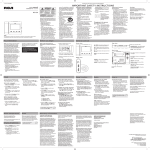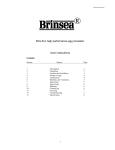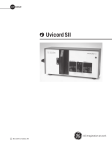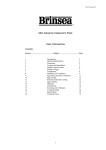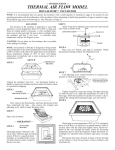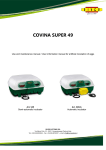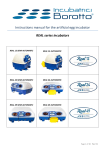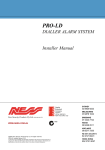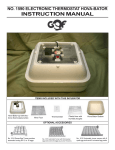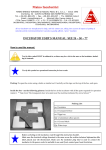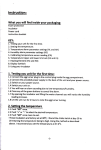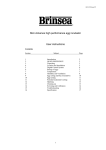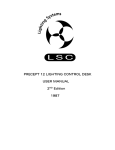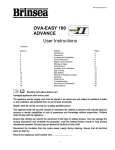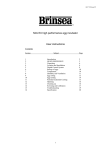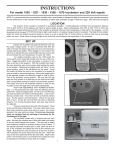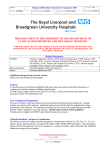Download BELLSOUTH 100 ELECTRONIC INCUBATOR
Transcript
BELLSOUTH 100 ELECTRONIC INCUBATOR Standard Manual Turning, pages 1-7 Fully Automatic Turning 9-13 Semi Automatic Turning 13 OPERATING INSTRUCTIONS FOR MANUAL EGG TURNING INCUBATOR IMPORTANT: READ THE INSTRUCTIONS THROUGH BEFORE COMMENCING USE CONTENTS In the box you will find the following items; a/ The top case containing the view port, heating element, electronic thermostat, indicator lamp, and temperature sensor. b/ The base with its cast water channels, and black cable entry bungs c/ A perforated steel floor on which the eggs are placed. d/ The thermometer and its mounting bracket. FIRSTLY For the best results the incubator should be used in a room which has a stable temperature about 20° C, with a minimum of 15° C, and a maxi mum temperature of 30° C. Do not place the incubator in a draft, in the sun, or near a heat source. Place the base of the incubator in the position where it is to be used. It is important that the incubator is level. This can be checked by filling the outer water channel until it is full all round. If the water is the same height on all sides, then the incubator is level. Leave the water in the channel as it will be required in normal use. The wire mesh can now be placed in the bottom of the base. BELLSOUTH Page 1 SECONDLY Remove the thermometer from its box. The stainless steel stand has two lines drawn on it. Bend the stand along the lines and then bolt the thermometer onto the stand. (See Fig 1) The bottom of the thermometer bulb should be level with, or just above, the top of the eggs. Adjust the height by bending the stand. (See Fig 2) Place the thermometer where it can be seen through the view port. The idea is to mimic the broody bird. The broody bird places the heat of her body on top of the eggs, so we place the thermometer to measure the temperature on top of the eggs. Page 2 BELLSOUTH THIRDLY Adjust the end of the temperature sensor lead until it is just clear of the top of the eggs. (See Fig 2). It is usual for the sensor to be l-3mm above the top surface of the egg. Place the top of the incubator over the base, and check that the thermometer is easily read through the view port. Do not put eggs in the incubator until temperature has been stabilized. Plug in the incubator to the 240Volt supply and immediately the indicator lamp will glow. This indicates that the heater is heating. The temperature control is on the top of the incubator. Turning the control CLOCKWISE will INCREASE the temperature. This is shown on the label on top of the machine. Watch the temperature rise until it just reaches 103° F on the thermometer. This will take up to 1 hour depending on the room temperature. It is important to monitor the incubator at this time, as the incubator can overheat and damage the thermometer if left set to maximum temperature for a long period. At this point turn the temperature control ANTICLOCKWISE until the indicator lamp just turns off. Leave the machine at least 1 hour to stabilise, then adjust the control up or down a little as indicated by the thermometer. Allow at least ten minutes between adjustments. Please note: Temperature is measured in Fahrenheit inside the incubator. The indicator lamp will tell you the following. a. If the indicator glows brightly, the element is giving full heat. b. If the lamp is turning on and off the temperature is stabilising, Wait for a another 10 minutes, then check the lamp turns off at 103F. c. If the lamp is off the heater has turned off. FOURTHLY If you haven’t done so, fill the outer water channel with warm water and you are ready to set eggs. Place the eggs on the wire, replace the lid, and leave the incubator to restabilise. Turn the eggs twice a day, once in the morning and once at night. BELLSOUTH Page 3 TEN RULES FOR GOOD HATCHING RESULTS 1) Healthy breeders lay healthy eggs. There is no replacement for eggs from birds correctly mated, in prime health, and fed on rations specially prepared for breeding. Ordinary laying rations do not have the vitamin concentrations required for excellent hatching results. Soluble vitamins added to the water are often the difference between excellent and average results. 2) Choose only those eggs which are smooth, clean, average in size and not deformed. Experience shows that other eggs will not hatch as well. 3) Once the egg is laid, nothing can be done to improve its hatchability. Poor storage will greatly reduce the hatch. Eggs should be stored at about 15°C, with a relative humidity of 85 % and they should be turned once a day. Eggs should be set within 7 days of being laid. 4) The key to successful operation is in the temperature. Remember the broody hen uses body temperature on the top of the eggs. So for good results, all eggs in the incubator should be close to the same size, thermometer set with the bottom of the black sensor bulb level with the top of the eggs, and 103 degrees F is the set temperature. Thermometer and temperature sensor should be at the same height as the top of the eggs but should not touch the eggs. See Fig 2. Remember a few minutes setting up correctly will save a lot of distress. 5) Turning the eggs. The turning of the eggs is the next most critical factor. Turning the eggs is important for allowing the embryo access to the nutrients in the egg. Turning should be done twice a day once in the morning and once at night. It is easier if the eggs are marked on one side with a cross and on the other with a zero. The eggs should be carefully turned a full 180 degrees. Avoid jarring and bumping the eggs as this can damage the embryos. 6) The moisture in the incubator is important as it prevents the egg from drying out. A dried out egg will not develop properly and will cause the chick to be stuck in the shell even if it lives to hatch time. Page 4 BELLSOUTH HOWEVER,too much moisture will mean that many chicks will actually drown in the egg before hatch time. Chicks with shell stuck on them, or chipped and not hatched, are symptoms of marginal high humidity. The water channels in the base provide correct moisture���������������������� ��������������������� for most situations. Select the inner channel for damp climates, the outer channel for normal climates, both channels for dry climates. However, in some rare cases, additional moisture may be added by sprinkling the eggs. Experience has shown that over 90% of situations will only require the outer water channel throughout the incubation process. So try the first batch with the outer channel and alter this if required. When using the automatic turner, start by filling only the inside water channel. Remember, too much water is just as bad as not enough so don’t use too much. TIP if the water dries out in less than a week, its on the dry side, if the water takes 2 weeks to dry out, then its on the wet side. Depth doesn’t matter, it is surface area that matters. 7) Candling the eggs is a useful technique for assessing the process of incubation. Candling is carried out in a darkened room using a small light source. This can be a torch with a cover attached and a hole about 15 to 20mm diameter. When directed at the large end of the egg the inside of the egg will be illuminated. Look through the side of the egg. This will show the air cell, and the growth of the embryo. The development of the air cell is shown in (Fig 3). The eggs should be candled at 7 days and any clear eggs, eggs where the embryo is stuck on the shell, or eggs with broken blood vessels should be removed. Experience will show up these eggs. Healthy embryos will show up as a spidery network of veins with a central embryo. . 8) Hatching time means special treatment for the eggs. The eggs should not be turned after 18 days (chicken eggs). Ensure that the outer water channel is full with warm water. Leave the lid on the incubator after this time and the humility will build up for the hatch. There is usually no need to add extra water to the incubator for the hatch. Too much water at this time will mean very wet chicks. If the chicks are too wet, then use only the inside water channel during the whole incubation period. BELLSOUTH Page 5 DO NOT OPEN THE LID again until all the chicks have hatched. Opening the lid at this stage will only damage the hatch. Many chicks are ruined lifting the lid to check the hatch. The chicks can be removed from the incubator once they have fluffed up. This will usually take up to 24 hours. The chicks should now be placed in a suitable brooder. 9) After removing the chicks from the incubator, the base should be washed before it dries out. Warm soapy water is used for cleaning the base. A few drops of White King in the water for the water channels will help kill any bacteria which has come into the incubator on the eggs. 10) Some hints on failures. Early hatch. Too high average incubator temperature. Late hatch. Too low average incubator temperature. Early deaths before 6 days. High temperature surge or poor egg stor age. Late deaths about 18 days not pipped. Poor breeder diet, inadequate humidity, incorrect temperature. Dead in shell, at pipping. Genetic factors, insufficient turning, incorrect temperature, or too much humidity. Wet chicks at hatch. High average humidity during incubation or at hatch time. 11) Diagnosing Machine Malfunctions Incubator temperature too low 1/ Possibly room temperature too low. If the lamp is on all the time and the incubator is below the set temperature this indicates the room temperature is too low and the incubator cannot make up the heat loss to the room, or perhaps there is a draft. Ensure that the incubator is not on the floor or near a window. If the temperature is too low when turned to maximum (+ direction), and the lamp is turning on and off, then the thermostat is out of calibration. Call BELLSOUTH Pty Ltd for advice. Check the thermometer, see page 8 below. Page 6 BELLSOUTH 2/ If the Temperature control is turned to the maximum (clockwise) direction AND the lamp is going on and off, then the thermostat is out of calibration (pre 2000 incubators) or the thermometer is faulty (see page 8 below) 3/ If the temperature is low, control turned full clockwise, and the lamp on or glowing very dull, and the element is cold, then it is likely a faulty element. 4/ Temperature too low, element cold, lamp off, possible blown fuse. (post 2000 incubators), or a dead thermostat. 5/ If the power is turned on, and the lamp flashes momentarily, but there is no heat, possible element failure. 6/ Do not cover the incubator with a towel if temp is low it will block the ventilation holes and upset the air distribution in the incubator. Incubator temperature too high. 1/ If the temperature is drifting upwards above 103F and the light is almost always off, this indicates the room temperature is close to the maximum allowable (30° C). This effect is most prominent in summer and with a full batch of eggs in the last 4 days of the hatch cycle. To assist, remove the bungs in the lid of the incubator to increase the airflow, or reduce the room temperature below 30 degrees. 2/ If the temperature is turning on and off, but the control is set to mini mum (- direction), then this indicates the thermostat is out of calibration. Call BELLSOUTH Pty Ltd for advice. 3/ Faulty thermometer. Thermometers are vital to correct operation and the use of different brands of thermometer may give quite different results. Always use the correct thermometer with your incubator. Temperature erratic. 1/ Room temperature varies too much. The ideal is around 20 degrees, but wide variations make it hard to achieve consistent temperatures. 2/ Corrosion or dirt on the thermostat. Replace thermostat. 3/ Worn control shaft. Touching the shaft, or tapping the lid causes the lamp to switch on and off. Replace thermostat. 4/ Temperature drifts and also humidity is high. Is the incubator on a plain table, or on carpet or a towel, which blocks the air ventilation holes. Place on plain table only. BELLSOUTH Page 7 Examining and Checking Thermometers Sometimes separations can occur in thermometers. These will cause inaccuracies. ANY breaks in the column will cause inaccuracies which will reduce results. Examine the thermometer at the beginning of any period of use, and ensure that the column in the thermometer is complete. Top thermometer reads lower than incubator temperature and the black blob at the very top cannot be repaired.Middle thermometer reads higher than incubator temperature. Bottom thermometer reads correct to the incubator temperature. For a more comprehensive explanation of incubation principles see: A Beginners Guide to incubation and Chick Rearing by J. Finger, A BELLSOUTH Publication. IF ALL ELSE FAILS REREAD THE INSTRUCTIONS BELLSOUTH Page8 Bellsouth 100 Automatic Turner Using the Bellsouth 100 New Turner. 1/ Parts Of Fully Automatic Turner a/ Side rails x 2 b/ End piece plain c/ End piece with motor and control, and motor clip. d/ Floor. e/ 12 tray dividers f/ Accessory pack g/ Power Plugpak 2/ Assembly. A/ Assemble the end pieces onto the side rails, Page 9 BELLSOUTH B/ slide the motor clip over the end piece, with the bottom tongue under the perforated mesh floor. The curved section of the clip should be to the top. Slide the clip on until the back of the clip is against the end piece. Place the assembled frame and perf mesh floor into the incubator base. Remove bung from the control end of the incubator base. the motor slightly to slide the tray into place. BELLSOUTH D/ Place the tray into the turner frame with the gear teeth under the motor. Lift PAGE 10 Check the side clearance of the floor inside the side rails. It should be 1mm to 3mm, if the side movement is more than 3mm, then use an extra tray divider between the polystyrene and side rail. D/ Check the motor is engaged in the gear, and plug in the power pack. Plug the power pak into a standard 240 volt power socket and swittch on. The tray will move towards the motor until it reaches the home location, then after 15 seconds the motor will run again, to an outward position controlled by the control knob. Pressing the button will cause the motor to run until it reaches its limit. PAGE 11 BELLSOUTH 3/ Loading A/ Place an egg on the tray and place the thermometer on one of the tray dividers using the bracket in the accessory pack, in a place where the thermometer can be read through the window. Adjust the height of the thermometer bulb to the top of the egg. See manual instructions, page 2 and 3. B/ Place the first tray divider near the motor end. Place a row of eggs on the tray and place a second divider in place. Ensure the dividers allow several millimetres clearance of the eggs. If the eggs touch both dividers at the same time they will skid and not roll over. Too many eggs in each row may make the eggs bind on each other. Fill the tray with rows making sure the rows are parallel. BELLSOUTH Page 12 C/ Press the button and check the eggs roll over, adjust the stroke if needed, anticlockwise will reduce the turn stroke, clockwise to increase the stroke. Page 12 BELLSOUTH 4/ Incubating eggs. A/ If the temperature has not been checked before installation, WATCH CAREFULLY after placing the lid on the incubator, to ensure the temperature is set correctly. Lamp should turn off at 103 Fahrenheit. B/ Use the auto turner until 3 days before hatch is due. It is best if the turner is removed during hatch to keep it clean. Chicks do best hatching on the mesh floor rather than in the turning tray. c/ Use the mini funnel to fill the water channels, the locator holes are marked on the base. Use a matchstick as a dipstick measure for the water level. 5/ Cleaning the turner. A/ It is important that the turner is kept clean so that it slides smoothly. Wash the floor, side rails and dividers in warm soapy water and make sure the roller in the side roll freely. DO NOT WASH THE DRIVE MOTOR, CONTROL BOX, OR POWER PACK. Wipe these with a damp cloth to keep clean. SEMI AUTOMATIC TURNER The use of the semi automatic is similar to the fully automatic in set up, with the exception that the drive is replaced with the push rod and knob found in the semi auto accessory pack. The thermometer mounting, tray spacing, and incubator operation are all the same. Egg turning should be a minimum of twice per day. Page 13 BELLSOUTH SEMI AUTOMATIC TURNER UPGRADE KIT The conversion from semi automatic to fully automatic is a simple procedure. The upgrade kit consists of a new end piece with drive and power pack. Installation. 1/ Remove the push rod from the tray, and remove the nut and bolt from the tray. Check the side float of the tray is 1 to 3mm ( see auto turn instructions page 10) 2/ Modify the tray using a knife or file to cut out a recess in the end of the tray for the stop switch. The cutout is 2 squares wide and one square deep and half height of the tray. Plan view showing the gear rack. End view showing half height of the tray. Angle view of cutout. 3/ Take off one old endpiece, slide the end upwards while holding the side rail down, and replace it with the new drive end piece. Fit the motor clip in place. see page 10. Make sure the tray is in so the teeth of the drive gear engage in the teeth of the tray. 4/ Plug in the power, test the turning, set up the eggs and thermometer as for Automatic turn pages 9-13. BELLSOUTH Page 14 REPLACEMENT KIT FOR OLD STYLE MOTOR The conversion from the old drive to the new drive is a simple procedure. The upgrade kit consists of a new end piece with drive, stainless motor clip, tray with gear rack, and power pack. Installation. 1/ Remove the old drive end piece from the side rails, slide the end upwards while holding the side rail down, Put the new end piece in place. Place the motor clip in place. Check the side float of the tray is 1 to 3mm ( see auto turn instructions page 10) 2/ Modify the tray using a knife or file to cut out a recess in the end of the tray for the stop switch. (see page 14) 3/ Place the tray back in the turner frame. Make sure the tray is in so the teeth of the drive gear engage in the teeth of the tray. 4/ Plug in the power, test the turning, set up the eggs and thermometer as for Automatic turn pages 9-13. PROUDLY MANUFACTURED IN AUSTRALIA BY: BELLSOUTH Pty Ltd Unit 8/5-7 Vesper Drive, Narre Warren 3805 (03) 9796 7044 Page 15 BELLSOUTH Some Incubation Settings and Times Temperature Set all eggs with thermometer level with top of the eggs, 103F. Remember if the temperature is correct hatch will occur on the correct day for the species. Humidity Judge correct setting by the air cell in the egg. Hatch Times ( stop turning 2-3 days before hatch) Chickens 21 days Bantams 20 days Ducks Domestic 28 days Muscovy Duck 25 days Goose 28 to 25 days dependent on species Quail Common European or Jap 17 days Bobwhite 23 days Pheasants 23 to 28 days dependent on species Partridge 23 days BELLSOUTH Page 16



















